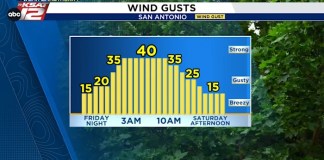The Barton Springs-Edwards Aquifer Conservation District declared a Stage 3 Exceptional Drought, effective Oct. 1, marking only the second time in its 38-year history.
The declaration follows a sharp drop in groundwater levels at the Lovelady monitor well, which fell below the district’s drought threshold.
The district manages portions of the Edwards and Trinity aquifers, supplying drinking water to nearly 100,000 residents from South Austin to southern San Marcos. It also oversees the groundwater that feeds Barton Springs, a vital ecological and recreational resource.
The declaration was prompted by sharp declines in groundwater, particularly at the Lovelady monitor well in South Austin. The well, located near 1st Street and Stassney Lane, is one of the area’s key indicators of aquifer health.
As of Sept. 11, water levels at the well averaged 457 feet above sea level, dipping well below the district’s drought threshold. For perspective, the long-term average for Lovelady is about 30 feet higher, at 490.9 feet.
This isn’t an isolated issue. Wells tapping into the Edwards and Trinity aquifers throughout the district are showing similar drops. These aquifers are crucial, providing drinking water for roughly 100,000 people in communities stretching from South Austin to southern San Marcos.
Every gallon saved helps preserve our shared water supply, as well as the iconic springs, creeks, and rivers of the area
Shay Hlavaty, Communications & Outreach Manager for the District
WHAT STAGE 3 MEANS
Stage 3 drought status triggers mandatory cutbacks for more than 120 groundwater permit holders, including cities such as Buda and Kyle, public water suppliers and private well owners. Reductions range from 30% to 100%, depending on the permit type.
While the district does not directly oversee how utilities implement these rules, residents should contact their local water provider to understand any restrictions in their area.
Noncompliance may result in monthly penalties.
WHY IT MATTERS
The reduced flow at Barton Springs, fed directly by the Edwards Aquifer, is another critical concern. These spring flows are not only important for the environment and recreation, but they also serve as a benchmark for assessing drought severity in the district.
To lift the drought designation, both the Lovelady well and Barton Springs must recover above their respective thresholds. Currently, neither shows signs of near-term improvement.
The region has been in continuous drought for 39 months, and rainfall totals continue to lag.
From March to September, the area received only 17.1 inches of rain, compared to the historical average of 22.2 inches. Since January 2022, the region has faced a rainfall deficit of 31.2 inches.
The only way to reverse this trend is through consistent, widespread rainfall, especially over the aquifer recharge zones in the Hill Country and areas west of Interstate 35.
TIPS FOR RESIDENTS
Every gallon counts—not just for us today, but for future generations and for the health of our rivers, springs, and ecosystems. With drought intensifying, we all need to step up our efforts to protect this shared resource.
Shay Hlavaty, the District’s Communications & Outreach Manager. “
While large-scale weather patterns are beyond our control, water conservation is something everyone can do. To help mitigate the drought’s impact, residents are urged to conserve water by adopting the following practices:
-
Limit outdoor watering: Avoid watering lawns and gardens unless absolutely necessary. Use drought-tolerant plants and mulch to retain soil moisture.
-
Fix leaks promptly: A single leaky faucet can waste hundreds of gallons per month.
-
Install water-efficient fixtures: Use low-flow showerheads, faucets, and toilets.
-
Shorten showers: Aim for five minutes or less.
-
Only run full loads: Use dishwashers and washing machines only when fully loaded.
-
Reuse water: Collect rainwater or reuse water from rinsing produce for plants.
-
Turn off the tap: Don’t let water run while brushing teeth or washing dishes.
These measures can help preserve the aquifer and ensure water availability for future generations.
Copyright 2025 by KSAT – All rights reserved.
Great Job Shelby Ebertowski & the Team @ KSAT San Antonio Source link for sharing this story.





